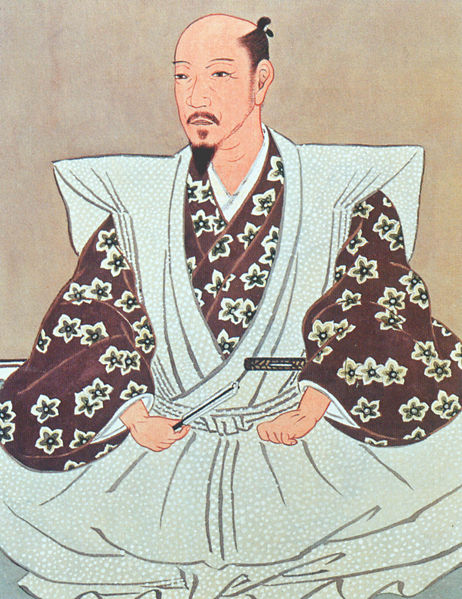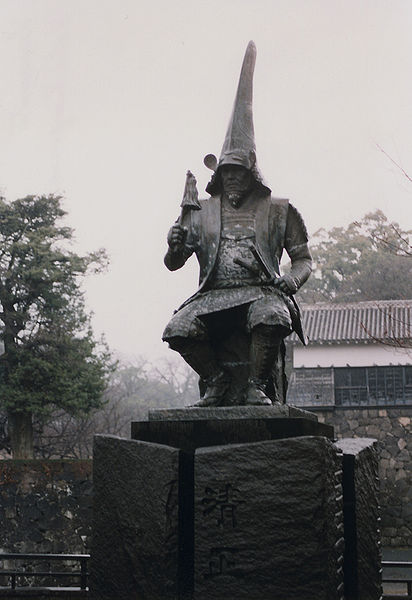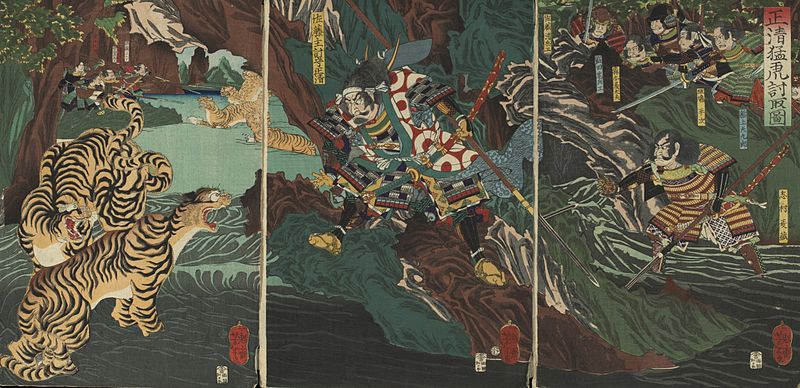<Back to Index>
- Mathematician Johann Benedict Listing, 1808
- Painter Maxfield Parrish, 1870
- Daimyō of the Edo Katō Kiyomasa, 1562
PAGE SPONSOR


Katō Kiyomasa (加藤 清正, July 25, 1562 – August 2, 1611) was a Japanese daimyō of the Azuchi - Momoyama and Edo period.
Kiyomasa was born in Owari Province to Katō Kiyotada. Kiyotada's wife, Ito, was a cousin of Toyotomi Hideyoshi's mother. Kiyotada died while his son (then known as Toranosuke) was still young. Soon after, Toranosuke entered service with Hideyoshi, and in 1576, at age 14, was granted a revenue of 170 koku. He fought in Hideyoshi's army at the Battle of Yamazaki, and later, at the Battle of Shizugatake. Owing to his distinguished conduct in that battle, he became known as one of the Seven Spears of Shizugatake. Hideyoshi rewarded Kiyomasa with an increased revenue of 3000 koku.
When Hideyoshi became the kampaku in the summer of 1585, Kiyomasa received the court title of Kazue no Kami (主計頭) and junior 5th court rank, lower grade (ju go-i no ge 従五位下). In 1586, after Higo Province was confiscated from Sassa Narimasa, he was granted 250,000 koku of land in Higo (roughly half of the province), and given Kumamoto Castle as his provincial residence.
Kiyomasa was one of the three senior commanders during the Seven - Year War (1592 – 1598) against the Korean dynasty of Joseon. Together with Konishi Yukinaga, he captured Seoul, Busan and many other crucial cities. He won the last Korean regulars in the Battle of Imjin River and pacified Hamgyong.
Kiyomasa was an excellent architect of castles and fortification. During the Imjin war, he built several Japanese style castles in Korea to better defend the conquered lands. Ulsan castle was one of these fortresses that Kiyomasa built, and it proved its worth when Korean - Chinese allied forces attacked it with far superior force, yet the outnumbered Japanese successfully defended the castle until the Japanese reinforcements arrived, which forced the Sino - Korean allies to retreat.
The Korean king Seonjo abandoned Seoul in fear of Kiyomasa. Kiyomasa held two Korean princes who had deserted as hostages and used them to force lower ranking Korean officials to surrender. He killed a tiger while hunting in the forest and presented to Hideyoshi the skin. Kiyomasa's most famous fight is the Siege of Ulsan (蔚山城の戦い) on December 22, 1593. Kiyomasa bravely succeeded in the fight defense though Chinese general Yang Hao (楊鎬) encircling Ulsan with 60,000 military forces. He defended frequent attacks from the Chinese army with Ulsan until November 23, 1598. However, his brave fight was not reported to Hideyoshi by his rival's overseer Ishida Mitsunari. After Hideyoshi's death, he conflicted with Ishida Mitsunari, and approached Tokugawa Ieyasu.
William Scott Wilson describes
Kato Kiyomasa thus: "He was a military man first and last, outlawing
even the recitation of poetry, putting the martial arts above all else.
His precepts show the single - mindedness and Spartan attitudes of the
man, (they) demonstrate emphatically that the warrior's first duty in
the early 17th century was simply to "grasp the sword and die."
Contemporary accounts of Kato describe him as awe - inspiring, yet not
unfriendly, and a natural leader of men."
A devoted member of Nichiren Shu Buddhism, Kiyomasa encouraged the building of Nichiren temples. He did not see eye - to - eye with Ishida Mitsunari, and Hideyoshi recalled him to Kyoto. He came into conflict with Konishi, who ruled the neighboring domain in Higo, and was a Christian. Kiyomasa was noted for brutally suppressing Christianity. At the battle of Hondo, he ordered his men to cut open the bellies of all pregnant Christian women and cut off their babies' heads.
During the Battle of Sekigahara, Kiyomasa remained in Kyūshū, siding with the eastern army of Tokugawa Ieyasu. For his loyalty to the Tokugawa, Kiyomasa was rewarded with the former territories of his rival Konishi (who had sided with Ishida), which when added to his existing territory, increased the Kumamoto domain to around 530,000 koku.
In his later years, Kiyomasa tried to work as a mediator for the increasingly complicated relationship between Tokugawa Ieyasu and Toyotomi Hideyori. In 1611, en route by sea to Kumamoto after one such meeting, he fell ill, and died shortly after his arrival. He was buried at Honmyōji temple in Kumamoto, but also has graves in Yamagata Prefecture and Tokyo. Kiyomasa is also enshrined in many Shinto shrines in Japan, including Katō Shrine in Kumamoto.
In 1910, Kiyomasa was posthumously promoted to junior 3rd court rank (jusanmi 従三位).
According to Korean records, the Japanese advance did not last long, however, for General Kato met heavy resistance the following year in the form of General Kwon Yul of the Joseon Army, Admiral Yi Sun - sin of the Korean Navy and Commander Li Rusong of the Chinese Ming salvage force. At the disastrous Battle of Haengju, Katō's army of 40,000 marched out of Seoul to capture nearby Haengju fortress where a small number of Korean soldiers and militia were holding. This turned into a disaster as the Japanese force was defeated by a Korean army of 2,800 (including 800 militia). Casualties were upwards of 10,000 men. (According to Japanese records, Kiyomasa was joined by Nabeshima Naoshige, and entered Seoul in February, 1593. He was researching the negotiation of China with Ukita Naoie at this time, which corroborates the Korean record.) This and many other defeats coupled with the breaking of supply lines from Japan by Admiral Yi Sun - sin forced Kato's retreat from Korea.
During
the Korean action, Konishi Yukinaga had also run into a fierce fighting
and tried to negotiate a peace treaty with the Korean and Chinese
forces surrounding him. "Kato was infuriated by the surrender attempt,
and upon his return to Japan he ravaged the Konishi family's
neighboring domain in retaliation."
